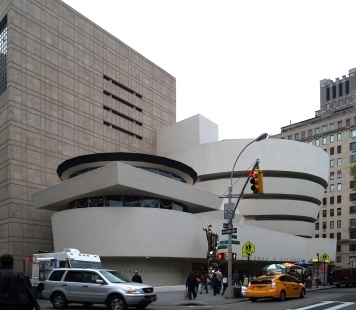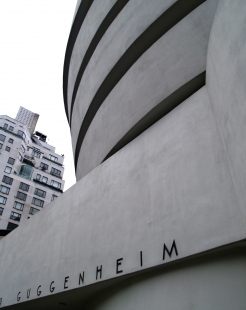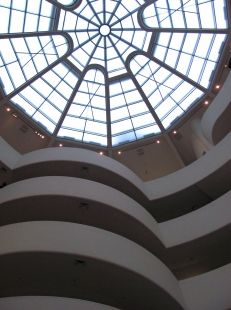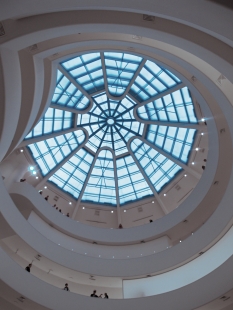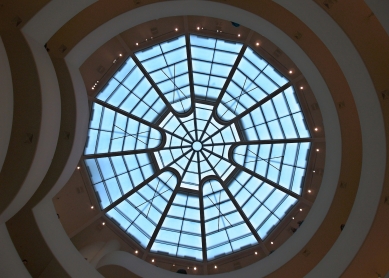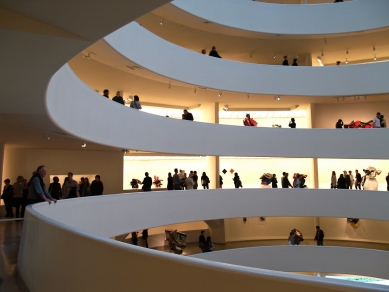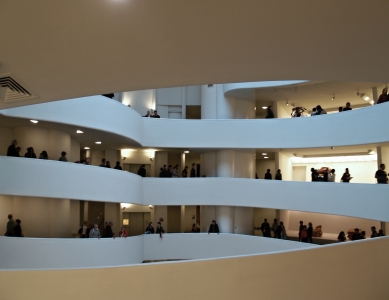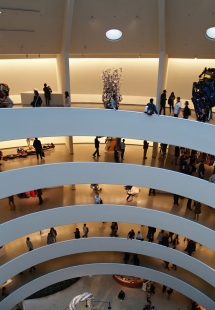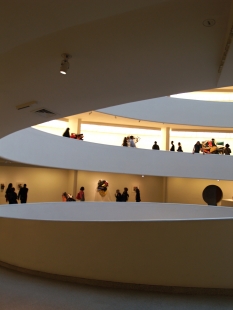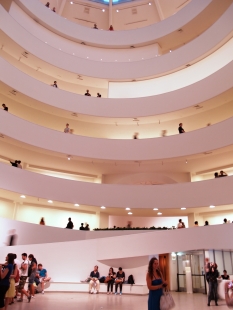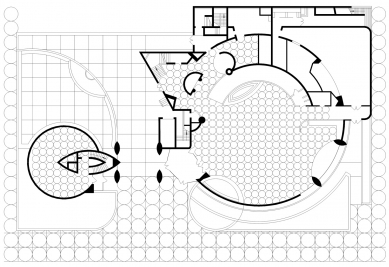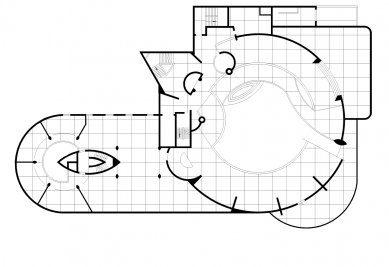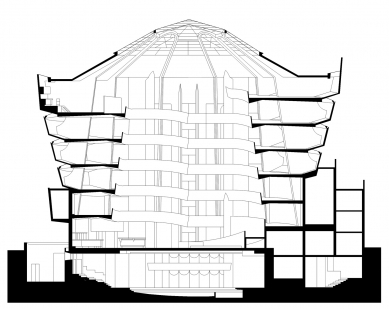
Solomon R. Guggenheim Museum

"Upon entering the interior, you will discover the best atmosphere in which it is possible to exhibit art or listen to music. It is the atmosphere that I miss the most in our galleries, museums, concert halls, and theaters."
The Solomon R. Guggenheim Foundation was born from the private collection of abstract art of a wealthy American industrialist, businessman, and philanthropist whose roots trace back to Switzerland. The collection supposedly originated from a bet between Solomon R. Guggenheim and his friend Hilla von Rebay that he could not draw his portrait. The baroness and painter, who sympathized with the Dadaists and was also close to the Bauhaus, introduced him to abstract art and helped him with a collection that laid the foundation for his foundation in 1937. She herself became its first director. Although the collection may have seemed extravagant and provocative in its time, it familiarized many visitors with abstract art. The foundation's collections quickly grew, and soon new, larger spaces were needed. In 1943, therefore, Solomon R. Guggenheim commissioned Frank Lloyd Wright to design a new building. Over 16 years, Wright presented six concepts that included 749 plans and sketches. Among other collaborators on the project was engineer Jaroslav Josef Polívka of Czech origin, who solved the construction of the rising concrete ramp without the need for supports that would occupy the free interior space. The museum was not completed until 1957, and neither Solomon R. Guggenheim nor Frank Lloyd Wright lived to see its opening.
Immediately after its opening, it became the target of sharp criticism and was nicknamed the hatbox or flying saucer, criticized for overshadowing the works themselves. Today it is an icon, and a large portion of visitors do not come for the exhibits but for the building itself. The museum has thus become the largest exhibit. The striking and provocative building is in sharp contrast to the rest of Manhattan, which adheres to a rectangular grid.
The concept consists of a rising, expanding spiral, which is clearly reflected in the external facade. The entrance area, with a low ceiling that prevents initial views from prematurely revealing the interior space, is soon replaced by the experience of a massive atrium that reveals the six-story, uncoiling ribbon of the ramp. When viewed from the bottom, the exhibited works are not dominant; before reaching them, one passes through the building, begins to perceive it, and realizes that they are in the midst of a work of art. The elevator takes them to the highest floor, and they smoothly descend down the gently sloping ramp around exhibits placed in niches along the periphery. The open central space allows views of exhibits from various angles, distances, and perspectives, keeping the visitor constantly at the center of the action. The building cannot be understood from one spot but rather through continuous movement. Everything takes place around the glass atrium, which provides sufficient daylight (this principle is unfortunately somewhat disrupted today due to multimedia art, as the skylight is covered to deal with the harsh sunlight, and the exhibits are artificially illuminated). It is an abstract structure for abstract art—the essence is continuity of space, the absence of any obstacles in movement, and the fluidity of the exhibition (all this is balanced by the fact that, for example, Picasso's Guernica could not be exhibited in this exhibition space).
However, the simple and clear idea also had its drawbacks. As later expressed by the museum director Thomas Messer, who held the position for an incredible 27 years, installing the exhibits was not easy at all. He discovered a way to tilt the sculptures and paintings so that they created an impression of verticality on the sloping and expanding ramp. Thomas Messer even managed, with his charm, to convince Peggy Guggenheim to donate her collections to the Guggenheim Foundation, which was no simple task, as the eccentric Peggy did not get along with her uncle.
The collections began to expand to include non-abstract art (Impressionists and 19th century) already under previous directors. Today, the foundation has five branches worldwide—in New York, Venice, Bilbao, Berlin, with a branch under construction in Abu Dhabi (designed by Frank O. Gehry, expected completion in 2017), and the branch in Las Vegas is closed. It is visited by almost three million people annually, making it one of the most visited cultural institutions in the world. The museum is located on what is known as Museum Mile, a section of 5th Avenue in the Upper East Side, named for the 10 museums located close together.
In 1992, the first wave of renovations to the interior and an extension of the museum in the form of the flat vertical Gwathmey Siegel Tower, named after its architect, took place. The second wave occurred from 2005 to 2008, during which the exterior of the museum was particularly renovated. A large group of restorers, architects, and engineers documented all cracks and damages of the facades and examined the composition of the original concrete, plasters, and coatings.
Paul Goldberg, an architecture critic, aptly characterized the Guggenheim Museum in New York with the words: "Previously, only two forms of museum were common—a neoclassical palace or a pavilion in the International Style—and Wright managed to sweep them away in one stroke. He designed a building suitable for a museum both from a cultural and a social perspective, creating an environment that is highly impressive and intense. In this sense, almost every museum of today's era is a descendant of the Guggenheim Museum."
Frank Lloyd Wright, The Architectural Forum, 1948
The Solomon R. Guggenheim Foundation was born from the private collection of abstract art of a wealthy American industrialist, businessman, and philanthropist whose roots trace back to Switzerland. The collection supposedly originated from a bet between Solomon R. Guggenheim and his friend Hilla von Rebay that he could not draw his portrait. The baroness and painter, who sympathized with the Dadaists and was also close to the Bauhaus, introduced him to abstract art and helped him with a collection that laid the foundation for his foundation in 1937. She herself became its first director. Although the collection may have seemed extravagant and provocative in its time, it familiarized many visitors with abstract art. The foundation's collections quickly grew, and soon new, larger spaces were needed. In 1943, therefore, Solomon R. Guggenheim commissioned Frank Lloyd Wright to design a new building. Over 16 years, Wright presented six concepts that included 749 plans and sketches. Among other collaborators on the project was engineer Jaroslav Josef Polívka of Czech origin, who solved the construction of the rising concrete ramp without the need for supports that would occupy the free interior space. The museum was not completed until 1957, and neither Solomon R. Guggenheim nor Frank Lloyd Wright lived to see its opening.
Immediately after its opening, it became the target of sharp criticism and was nicknamed the hatbox or flying saucer, criticized for overshadowing the works themselves. Today it is an icon, and a large portion of visitors do not come for the exhibits but for the building itself. The museum has thus become the largest exhibit. The striking and provocative building is in sharp contrast to the rest of Manhattan, which adheres to a rectangular grid.
The concept consists of a rising, expanding spiral, which is clearly reflected in the external facade. The entrance area, with a low ceiling that prevents initial views from prematurely revealing the interior space, is soon replaced by the experience of a massive atrium that reveals the six-story, uncoiling ribbon of the ramp. When viewed from the bottom, the exhibited works are not dominant; before reaching them, one passes through the building, begins to perceive it, and realizes that they are in the midst of a work of art. The elevator takes them to the highest floor, and they smoothly descend down the gently sloping ramp around exhibits placed in niches along the periphery. The open central space allows views of exhibits from various angles, distances, and perspectives, keeping the visitor constantly at the center of the action. The building cannot be understood from one spot but rather through continuous movement. Everything takes place around the glass atrium, which provides sufficient daylight (this principle is unfortunately somewhat disrupted today due to multimedia art, as the skylight is covered to deal with the harsh sunlight, and the exhibits are artificially illuminated). It is an abstract structure for abstract art—the essence is continuity of space, the absence of any obstacles in movement, and the fluidity of the exhibition (all this is balanced by the fact that, for example, Picasso's Guernica could not be exhibited in this exhibition space).
However, the simple and clear idea also had its drawbacks. As later expressed by the museum director Thomas Messer, who held the position for an incredible 27 years, installing the exhibits was not easy at all. He discovered a way to tilt the sculptures and paintings so that they created an impression of verticality on the sloping and expanding ramp. Thomas Messer even managed, with his charm, to convince Peggy Guggenheim to donate her collections to the Guggenheim Foundation, which was no simple task, as the eccentric Peggy did not get along with her uncle.
The collections began to expand to include non-abstract art (Impressionists and 19th century) already under previous directors. Today, the foundation has five branches worldwide—in New York, Venice, Bilbao, Berlin, with a branch under construction in Abu Dhabi (designed by Frank O. Gehry, expected completion in 2017), and the branch in Las Vegas is closed. It is visited by almost three million people annually, making it one of the most visited cultural institutions in the world. The museum is located on what is known as Museum Mile, a section of 5th Avenue in the Upper East Side, named for the 10 museums located close together.
In 1992, the first wave of renovations to the interior and an extension of the museum in the form of the flat vertical Gwathmey Siegel Tower, named after its architect, took place. The second wave occurred from 2005 to 2008, during which the exterior of the museum was particularly renovated. A large group of restorers, architects, and engineers documented all cracks and damages of the facades and examined the composition of the original concrete, plasters, and coatings.
Paul Goldberg, an architecture critic, aptly characterized the Guggenheim Museum in New York with the words: "Previously, only two forms of museum were common—a neoclassical palace or a pavilion in the International Style—and Wright managed to sweep them away in one stroke. He designed a building suitable for a museum both from a cultural and a social perspective, creating an environment that is highly impressive and intense. In this sense, almost every museum of today's era is a descendant of the Guggenheim Museum."
The English translation is powered by AI tool. Switch to Czech to view the original text source.
16 comments
add comment
Subject
Author
Date
Ma vubec nejaky smysl
A.J.K.
13.10.12 11:30
Nějaký smysl?
Dr.Lusciniol
16.10.12 01:48
Ano, jde o atrakci.
T. Fiala
16.10.12 07:49
Spirála FLW
Vích
17.10.12 10:34
židovské muzeum v Berlíně
Josef Smola
17.10.12 07:06
show all comments





